Writing great page titles is an essential skill for anyone doing SEO. Why? Because the title tag can be the first thing a user sees in the search results and it’s also one of the most important factors that Google uses to determine the topic of a page. This makes page titles essential to SEO and this article covers both why you need great page titles and how to create them.
Table of contents
- What is a page title?
- What’s the (SEO) purpose of a page title?
- What does the SEO title check in Yoast SEO do?
- How to write a title with an optimal width for SEO
- What does the keyphrase in title assessment in Yoast SEO do?
- How to use your keyphrase in the SEO title
- Should you add your brand to the SEO title?
- Optimizing page titles after publication
- Titles for social media
- Conclusion: Page titles – craft them well!
Yoast SEO also checks if you’ve used your keyphrase in the SEO title. Read about how that check works, and how to use your keyphrase in the title.
What is a page title?
Let’s start with the basics. If you look at the source of a page (right-click on the page, then choose View Page Source), you find a title in the head section. It looks like this:
<title>This is an example page title - Example.com</title>
This is the HTML title tag, which we also call the page title or SEO title. When you look something up in a search engine, you get a list of results that appear as snippets. Often, the SEO title is part of the snippet together with at least a URL and a meta description. Of course, some rich results also display ratings and other additional information.

In most cases, the first thing people see, even before they get on your site, is the SEO title. Just to be clear, you should not confuse the SEO title with the main heading of the page. The main heading is what users see after they click on the SEO title and get on the page itself.
In tabbed browsers, you will usually also see the SEO title in the page tab, as shown in the image below.

But, Google won’t always use your page title
In August 2021, Google announced an update on how they generate web page titles. This means that sometimes they will show a different title in their search results than the one you set. Before we get into that, it’s good to note that in most cases (more than 80% of the time) the HTML title tag that your page outputs is still the most likely used.
Although we’re talking about an update here, Google deciding on how to display your page title in the search results is nothing new. They’ve been doing this for a while now. What is new is that they now want to use one title only, and won’t change it up anymore for different search queries. And that they will use different elements on your page to decide on what this title displayed in the search results will be. Elements such as your title tag, headings, prominent text on the page, and even how you link internally to this page.
So what does this mean for you? Right now these changes don’t require you to do anything different. The page title you set is still very likely to be used, and more importantly, your page title helps you rank for a keyword. These changes don’t impact your page rankings. The title you give is what Google will look at when deciding how your page ranks. Just like before.
But, with all these changes, it doesn’t hurt to keep an eye on how Google displays the titles of your most important pages! So we recommend you monitor the situation with your site for the time being. Keep an eye on Google Search Console, spot-check your search results, and look out for changes in the click-through and bounce rates for your key pages. If you find anything problematic (or just really, really wrong) you can let Google know in this feedback thread.
What’s the (SEO) purpose of a page title?
The purpose of your SEO title is to make people click on it, visit your website and read your post or buy your product. If your title is not good enough, people will ignore it and move on to other results. Essentially, there are two goals that you want to achieve with a title:
- It must help you rank for a keyword;
- it must make the user want to click through to your page.
Google uses various signals when deciding how relevant you are for a specific keyword. Even if you’re initially ranking well, but nobody is clicking on your result, your rankings might deteriorate over time. The opposite is also true. At first, you may be positioned lower in the search results. But, if your title gets people to click on it, Google will notice. Consequently, over time, your rankings may improve.
Also, as mentioned before, Google uses what has been specified as your page title as ranking input. So it’s not just about those clicks, you also need to make sure that your page title reflects the topic being discussed on your page and the keyword that you’re focusing on. The page title you use has a direct influence on your ranking.
Now that you know about the importance of SEO titles, you’ll be pleased to know that Yoast SEO can help you craft them. In its SEO analysis, the plugin checks two crucial aspects of the SEO title: the width of your title and whether you use your keyword.
What does the SEO title check in Yoast SEO do?
Note: as Google has recently changed the way they generate page titles, we’re working on updating the SEO title checks in Yoast SEO too. The new checks will be available soon, so don’t forget to update your plugin!
You find this assessment in the SEO tab of the Yoast SEO sidebar or meta box. If you haven’t written a title yet, the assessment will remind you to do so. In addition, Yoast SEO checks the width of your title. When it is too long or too short, you will get a warning. A title with an optimal width gets you a green bullet in the analysis.
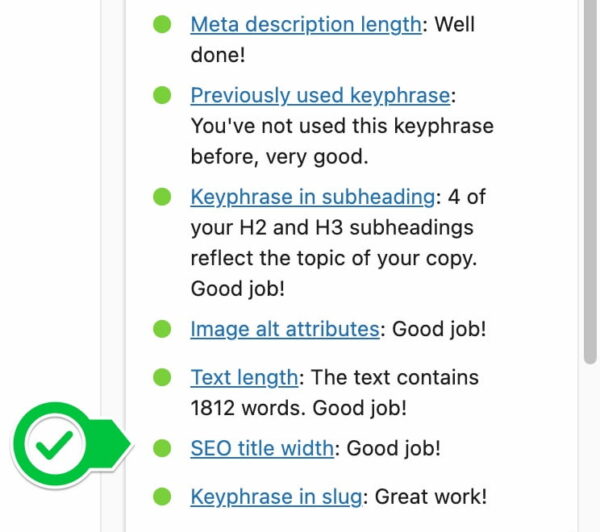
How to write a title with an optimal width for SEO
If your title doesn’t have the right width, parts of it may be cut off in Google’s search results. How the result looks may vary, depending on the device you’re using. That’s why you can also check how your SEO title will look in the mobile and desktop search results in the Google preview in Yoast SEO. The tool uses the mobile version as a default, but you can also switch to view it in the desktop version.
Here’s a desktop result:

And here’s the mobile result for the same URL:
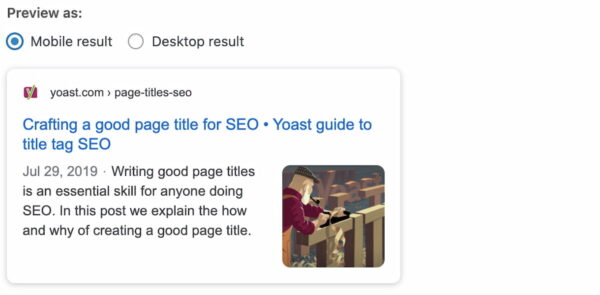
Width vs. length
Have you noticed that we talk about width rather than length? Why is that? Rather than using a character count, Google has a fixed width for the titles counted in pixels. While your title tags can be long and Google doesn’t have a set limit on the number of characters you can use, there is a limit on what’s visible in the search results. If your title is too wide, Google will cut it off visually. That might not be what you want. Also, you should avoid wasting valuable space by making the title too short. Not only that, the title often informs other title-like elements, such as the og:title , which also have display constraints.
Luckily our Google preview can help you out! You can fill in your SEO title and our plugin will give you feedback straight away. The green line underneath the SEO title turns red when your title is too long. So keep an eye on that, and use the feedback to create great titles.
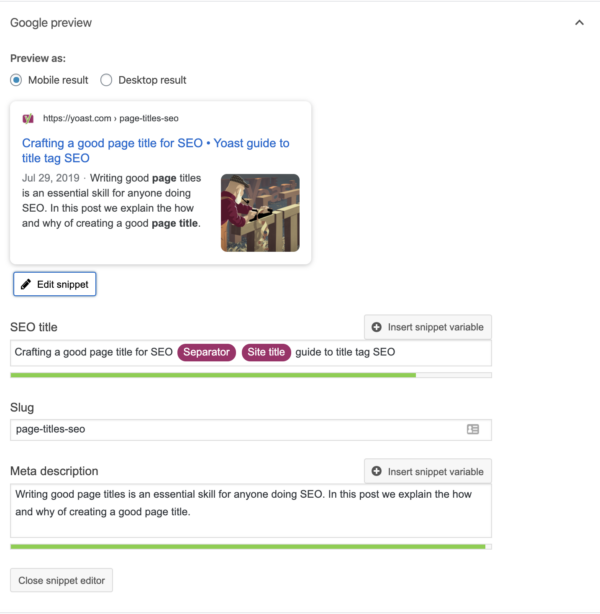
What does the keyphrase in title assessment in Yoast SEO do?
This assessment also appears in the SEO tab of the Yoast SEO sidebar and meta box. It checks if you’re using your keyphrase in the SEO title of your post or page. The plugin check for this is quite strict. Since Google uses the title to figure out your page’s topic, not having the focus keyphrase in the title may harm your rankings. In addition, potential visitors are much more likely to click on a search result that exactly matches what they were looking for. For the best results, you should try to add your keyphrase at the beginning of the SEO title.
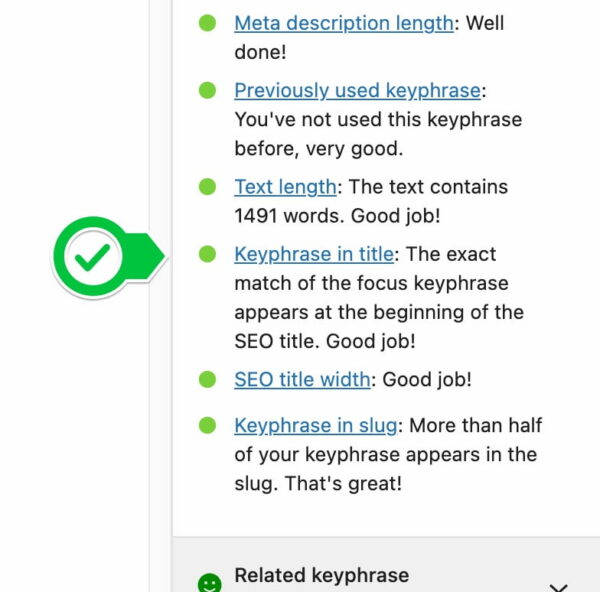
How to use your keyphrase in the SEO title
Sometimes, when you’re optimizing for a high-competition keyword, everyone will have the keyword at the beginning of the page title. In that case, you can try making it stand out by putting one or two words in front of your focus keyword, thereby slightly “indenting” your result. In Yoast SEO, if you start your SEO title with “the”, “a”, “who” or another function word followed by your keyphrase, you’ll still get a green bullet.
Other times, like when you have a very long keyphrase, adding the complete keyphrase at the beginning doesn’t make sense. If your SEO title looks weird with the keyphrase at the beginning, try to add as much of the keyphrase as you can, as early in the SEO title as possible. But always keep an eye on the natural flow and readability of your title.
Want to learn all about how to write a text that’s pleasant to read and optimized for search engines? Our SEO copywriting course can help you with that. You can get access to this course, and all of our other SEO courses, with Yoast SEO Premium. This also gives you access to extra features in the Yoast SEO plugin.
Go Premium and get free access to our SEO courses!
Learn how to write great content for SEO and unlock lots of features with Yoast SEO Premium:
Should you add your brand to the SEO title?
For quite some time it was a fashion among some SEOs to leave the site name out of the page title. The idea was that the “density” of the title mattered, and the site name wouldn’t help with that. Don’t do this. Your page title needs to have your brand in it, preferably in a recognizable way. If people search for a topic and see your brand several times, even if they don’t click on it the first time, they might click when they see you again on their next page of results.
If you don’t include your site name in your title tag, you’ll also run the risk of Google automatically changing the title for you. As explained in our article on why isn’t Google showing my page title, Google thinks it needs to be there too. If you want to read more about branding, be sure to read this post by Marieke: 5 tips on branding.
Optimizing page titles after publication
A while ago, while looking at our Google Search Analytics data for yoast.com, I noticed that, while we ranked well for [wordpress security], we weren’t getting a lot of traffic for it. I optimized the page title and meta description for our WordPress security article and this increased traffic by over 30%. My changes to the title were done around the same time as the update – indicated by the vertical line in the graph below:

The change was fairly simple. Instead of the title being:
WordPress Security • Yoast
I changed it to:
WordPress Security in a few easy steps! • Yoast
As you can see, this doesn’t necessarily improve the rankings of this page at all. From a keyword perspective, the title isn’t much better, but it is more enticing, and it did lead to many more clicks, which, of course, was the desired result.
Titles for social media
What might be a good title tag for SEO isn’t necessarily a good title for social media. In social media, keyword optimization is less important than creating a title that entices people to click. You often don’t need to include the brand name in the title. This is especially true for Facebook and Twitter if you include some form of branding in your post image. Our social previews in Yoast SEO Premium can help you with that.
If you’re using Yoast SEO, you can have a separate title for Facebook, Twitter, and Google. Just enter the Google title in the Yoast SEO snippet editor. The Facebook and Twitter title can be entered on the social tab in their respective fields. If you don’t enter a specific Twitter title, Twitter will use the Facebook title instead.
Conclusion: Page titles – craft them well!
In conclusion, the main point of this article is to encourage you to invest a little more time in writing good page titles. It really is worth it. Going back and optimizing some of your page titles after publication might also be worthwhile. This is especially true if you’re already ranking well, but aren’t getting very many clicks.
Read more: How to create the right meta description »
The post How to craft great page titles for SEO appeared first on Yoast.

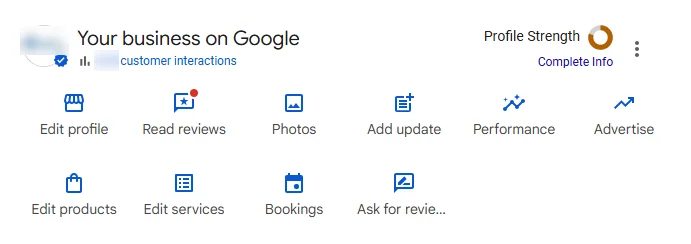

Recent Comments